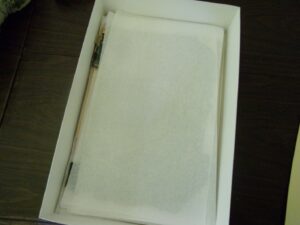If you’re feeling overwhelmed by the thought of preserving a scrapbook, fear not! Melissa Barker, also known as the Archive Lady, addresses a common question about preserving scrapbooks. Melissa shares her expertise and offers five easy steps for archiving and preserving these cherished time capsules.
Questions for a Professional Archivist
Gloria in Alabama asks “I am trying to get organized in 2020 and I have several scrapbooks that belonged to my aunt. My aunt was into everything and she saved everything in her scrapbooks. What is the best way to preserve and archive scrapbooks?”
Scrapbooks are a genealogist’s gold mine! If you ask anyone that knows me, they will tell you that my favorite record collection to do research in and to process in the archive is scrapbooks. I am asked about preserving scrapbooks a lot because they can be intimidating but they don’t need to be.
Scrapbooks are like time capsules; nobody knows what will be found in them until they are opened. There are different styles of scrapbooks from newspaper clippings, obituary, diary, sports teams, personal history and many more. Many ancestors painstakingly glued all kinds of documents, photographs, and ephemera into scrapbooks to remind them of what they experienced during their lifetime and to pass along those experiences to their descendants.

Scrapbooks at the Houston County, TN. Archives & Museum
Archiving and preserving scrapbooks is quite easy and anyone can do it with these five easy steps.
Step 1: Digitize Every Page of the Scrapbook
Use a flatbed scanner, digital camera or an overhead scanner.DO NOT use any kind of self-feeding scanner or a handheld scanner. These types of scanners could potentially damage the pages or the items pasted to the pages. Make sure to digitize the scrapbook in original order from the first page to the last page. Be sure to label the digitized images and include metadata about each image.
Step 2: Purchase Archival Tissue Paper
Archival tissue paper can be purchased at any online archival materials store (see list below). It is a good idea to get a size that is about 1/4″ to 1/2″ larger than the scrapbook page. This will ensure that the tissue paper covers the entire scrapbook page. If you have larger pieces of tissue paper, cutting the tissue paper to size is perfectly fine. If there are items coming loose or falling out of the scrapbook, use plastic paper clips to clip them to the page where they belong. DO NOT use any kind of glue to paste the item back into the scrapbook.
Step 3: Use tissue paper
Place the tissue paper in between each and every page of the scrapbook. The tissue paper will act as a shield to protect anything on the pages from bleeding onto or damaging the adjoining page. Also, if any items are falling out of the scrapbook and exposing the glue, the tissue paper will keep the glue from touching items on other pages.

Tissue Paper Interweaved in Scrapbook, Houston County, TN. Archives
Step 4: Use Archival Boxes
Purchase an archival box that is as close to the size of the scrapbook as possible. The box that is used should be a flat box with a separate lid. Do not use an upright Hollinger box or other box that requires that the scrapbook be stored standing on its end. It is important that all scrapbooks be stored laying down. Place a piece of tissue paper in the bottom of the box, then lay the scrapbook on the tissue paper. If there is still room in the box and the scrapbook is sliding around, crumple up archival tissue paper and tuck it around the scrapbook to secure it in place so it doesn’t move. The scrapbook should fit snuggly so that it doesn’t move around in the box.

Boxed Scrapbook, Houston County, TN. Archives
Step 5: Label for Easy Retrieval
Label the box with information about the scrapbook. For instance, “World War II Scrapbook, Belonged to John Jones, 1941-1945”. Store the boxed scrapbook in a cool, dry, and dark place. Keep away from sunlight and handle the scrapbook as little as possible. Consult with the digital images as much as possible so that damage is not done to the original scrapbook from handling.
These 5 easy steps to preserve scrapbooks will ensure they will survive for many years to come.
Archival Material Websites
Melissa suggested these sites as places to shop for the needed materials.



